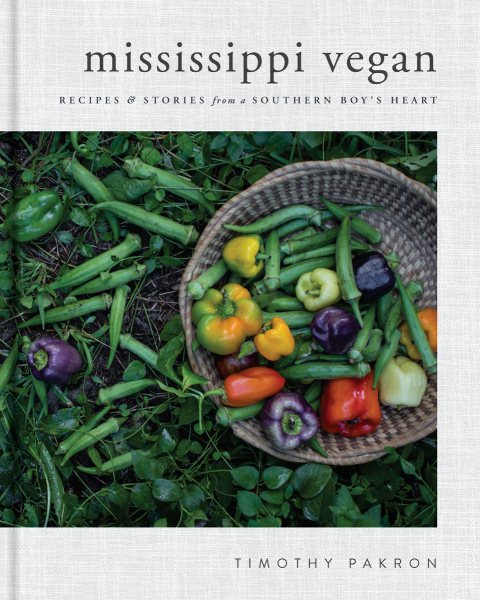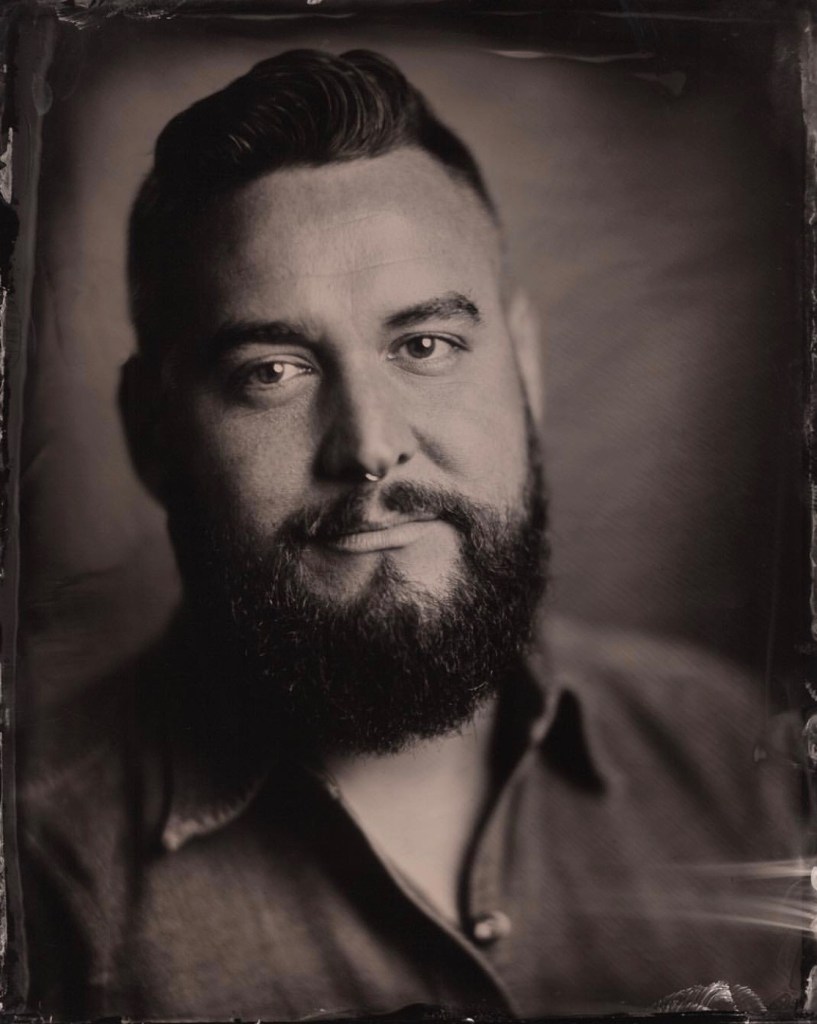Interview by Jana Hoops. Special to the Clarion-Ledger Sunday print edition (December 9)
Mississippi native and vegan enthusiast Timothy Pakron has combined his passions as an artist, photographer and recipe developer into a debut cookbook like no other.
Mississippi Vegan: Recipes and Stories from a Southern Boy’s Heart was written, he says, “in a rather unconventional way.”
 Instead of hiring a photographer, food stylist, and “a team of people” to help, Pakron shot all of the photos himself, wrote all the text, and invited friends from all over the world to come to his Mississippi Gulf Coast home to help him “cook, document, and style the food” that became the recipes in his book.
Instead of hiring a photographer, food stylist, and “a team of people” to help, Pakron shot all of the photos himself, wrote all the text, and invited friends from all over the world to come to his Mississippi Gulf Coast home to help him “cook, document, and style the food” that became the recipes in his book.
And the research, he notes, was constant: he made countless phone calls to his mother.
With the majority of the recipes in Mississippi Vegan being dishes he said he could only “remember in my mind,” that communication was a necessity–although many others were “picked and pulled” from lessons he’s since learned on his own, adding fresh, original dishes to his family recipes.
As one who was always been drawn to the idea of a vegan diet, Pakron not only loves the food but has embraced “vegan” as a lifestyle that he wants to share enthusiastically.
Pakron’s biggest hope is that readers understand Mississippi Vegan as a concept, not a specific location.
“It’s a constant celebration of delicious food, memories, and pride in growing and sourcing local produce,” he states in the book’s introduction. “It’s an exploration of nature and a constant search for beauty that exists in this world.”
Today Pakron lives in New Orleans, where he is refining his blog and weighing a variety of options for his next creative step.
Please tell me about your education and culinary training, your career, and what eventually brought you to New York City.

Timothy Pakron
When I was young, I would always watch my Mama cook in the kitchen. When I was a teenager, she taught me how to make gumbo. Later on, I went to College of Charleston in Charleston, S.C., where I majored in studio art, which included printmaking, painting, sculpture, and photography. Upon graduating, I began showing my art in galleries while also working a multitude of different jobs.
I moved to New York in my mid-20s to pursue my career as an artist. Eventually, I felt dissatisfied and begin focusing on food styling, food photography, and recipe development. By working as a server in three different vegan restaurants and hosting pop-up events where I was cooking all of the food, I gained a lot of experience in the food and beverage world.
Explain what it means to follow a vegan diet, and why adopting it was so important to you.
Following a vegan diet celebrates the abundance of plants and mushrooms. As long as the ingredient is a plant or a mushroom–fruit, vegetables, nuts, seeds, grains, legumes, shiitakes, criminis, etc.–then it is vegan. If the recipe is an animal product or is an animal by-product, it is not vegan. Eating a vegan diet is important to me because I could not and will not harm animals in any way. Eating plant-based is also healthy and beneficial to the environment, as it is more sustainable than factory farming animals.
Specifically, how do you define “Mississippi Vegan”?
“Mississippi Vegan” is a concept that merges my past and my present. It is a celebration of the abundance of edible plants and mushrooms, creativity, delicious recipes, beautiful photography, and laughter. “Mississippi Vegan” focuses on what vegans do eat instead of focusing on what vegans do not eat. “Mississippi Vegan” is love.
You were living and working in New York City when you decided to create this book, and you realized that the only way you could write it would be to move back to Mississippi. Why was that a necessary part of the project for you, and why did you say that writing this book in Mississippi was “incredibly emotional” for you?
It was necessary because the whole premise of the book was to show people the undercurrent of veganism that exists within the food from my home state–in particular, the region I was raised, the Gulf Coast.
It was incredibly emotional to me because I wrote a book about recipes from my childhood which brought back many memories. I also had not lived in Mississippi for over a decade, so to be back home and pursue such a large creative endeavor in my home state was overwhelming while also beautiful at the same time.
In the book, you describe yourself as a recipe developer, a photographer, and an artist. What role did each of these play in the creation of “Mississippi Vegan”?
Well, for many cookbooks the author will hire a food stylist and a food photographer to shoot their book. Some authors will even hire a ghostwriter to help them with the written material. I did not. I styled and shot everything myself. I wrote every word. I also created all of the recipes or made veganized translations of all of the recipes myself. It was a true labor of love and is 100 percent authentic.
How do you go about creating a new recipe–what are some of the standards or requirements that a recipe must meet to earn the Timothy Pakron seal of approval?
With all of my recipes, I like to push people a little bit, whether it be with new ingredients or using ingredients in a different way. I also want to make sure everything is super flavorful. When I can re-create a traditional recipe that reminds me of my past while also veganizing it, that’s what gets me the most excited!
This book is unique in many ways, including the fact that you did all the photography yourself. Tell me about that process.
It was overwhelming, exciting, fun, and stressful. What most people probably think is that the process was effortless, because the reader sees all of the perfectly composed images laid out beautifully in a book. In fact, there were some recipes I shot over and over and again and I couldn’t get the perfect shot. Some of the images just weren’t good enough!
The other issue I ran into was the fact that I was photographing Southern food, which is inherently not very pretty. Cheese straws, mashed potatoes, gumbo, and Salisbury steak, albeit delicious, are kind of ugly! Now that the project is over, I can honestly say that I am so very proud because I did everything for the book. It truly is my baby.
While “going vegan” seems to be growing in popularity today, some are skeptical for a variety of reasons, including how all nutritional needs are met, especially when it comes to sources of protein. How would you counter that argument?
The whole protein concern is honestly antiquated. I’ve created a career on celebrating vegan food, and if you get one look at me you will quickly notice that I do not look protein deficient! The fact of the matter is that all plants have protein, some more than others, and there is plenty of high-quality protein in things like legumes, nuts, seeds, peanuts, greens, root vegetables, and even things like fruit.
When it comes to vitamins and minerals, plants and mushrooms are amazing sources of both. I invite people to do their own research from reputable sources, not hearsay. There are plenty of books, articles, and documentaries on the topic.
You mention in the book that there will no doubt be new adventures and chapters in your life that will see you moving away from Mississippi once again. Can you share other ideas or projects you’d like to explore? And do you foresee new books as a result?
Well, a few months after I finished my book, I decided to move to New Orleans to start a new chapter in my life. And I love it here! This year I am really focusing on my blog, making sure to consistently post recipes. I could see myself writing another book, but I need a break first! If I had to mention anything, I wouldn’t be surprised if I had a streaming TV show of some kind in the future. We shall see!


Comments are closed.